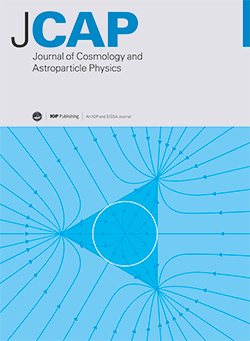Measuring the cosmic dipole with golden dark sirens in the era of next-generation ground-based gravitational wave detectors
IF 5.3
2区 物理与天体物理
Q1 ASTRONOMY & ASTROPHYSICS
Journal of Cosmology and Astroparticle Physics
Pub Date : 2025-07-23
DOI:10.1088/1475-7516/2025/07/076
引用次数: 0
Abstract
The tensions between cosmological parameter measurements from the early-universe and the late-universe datasets offer an exciting opportunity to explore new physics, if not accounted for unknown systematics. Apart from the well-known Hubble tension, a tension up to ∼4.9σ in the cosmic dipole has also been reported. While the cosmic dipole is mainly induced by the observer's kinetic motion, an intrinsic dipole arising from the anisotropy of the universe could also play an import role. Such an intrinsic anisotropy can be a dark energy mimicker that causes the observed accelerating expansion of the universe. As a new and powerful tool, gravitational waves can serve as an independent probe to the cosmic dipole. A useful type of events to achieve this is the “golden dark sirens”, which are near-by well-localized compact binary coalescences whose host galaxies can be identified directly due to precise localization. By forecasting golden dark sirens obtained from 10-year observations using different possible detector networks in the future, we find that the standard LIGO-Virgo-KAGRA detectors are not able to detect a meaningful amount of golden dark sirens, and hence next-generation ground-based detectors are essential to obtain a strong constraint on the cosmic dipole. In particular, we find that a three-detector network consisting of more than one next-generation detectors can yield a constraint on the cosmic dipole at an order of 10-3 when jointly measured with H0. Moreover, a constraint on the cosmic dipole at an order of 10-4 can be achieved when fixing H0.在下一代地面引力波探测器时代,用金色的黑暗警报器测量宇宙偶极子
早期宇宙和晚期宇宙数据集的宇宙学参数测量之间的紧张关系提供了一个令人兴奋的机会来探索新的物理学,如果没有解释未知的系统。除了众所周知的哈勃张力,宇宙偶极子中高达4.9σ的张力也被报道过。虽然宇宙偶极子主要是由观察者的动力学运动引起的,但由宇宙各向异性引起的本征偶极子也可能起重要作用。这种固有的各向异性可能是暗能量的模仿者,导致观测到的宇宙加速膨胀。引力波作为一种新的强大工具,可以作为宇宙偶极子的独立探测器。实现这一目标的一种有用的事件类型是“金色黑塞壬”,它是附近定位良好的致密双星合并,其宿主星系可以通过精确定位直接识别。通过预测未来使用不同可能的探测器网络进行10年观测获得的金色暗警报声,我们发现标准的LIGO-Virgo-KAGRA探测器无法探测到大量的金色暗警报声,因此下一代地面探测器对于获得对宇宙偶极子的强约束至关重要。特别是,我们发现由一个以上的下一代探测器组成的三探测器网络在与H0联合测量时可以产生10-3阶的宇宙偶极子约束。此外,当固定H0时,可以实现对宇宙偶极子在10-4阶的约束。
本文章由计算机程序翻译,如有差异,请以英文原文为准。
求助全文
约1分钟内获得全文
求助全文
来源期刊

Journal of Cosmology and Astroparticle Physics
地学天文-天文与天体物理
CiteScore
10.20
自引率
23.40%
发文量
632
审稿时长
1 months
期刊介绍:
Journal of Cosmology and Astroparticle Physics (JCAP) encompasses theoretical, observational and experimental areas as well as computation and simulation. The journal covers the latest developments in the theory of all fundamental interactions and their cosmological implications (e.g. M-theory and cosmology, brane cosmology). JCAP''s coverage also includes topics such as formation, dynamics and clustering of galaxies, pre-galactic star formation, x-ray astronomy, radio astronomy, gravitational lensing, active galactic nuclei, intergalactic and interstellar matter.
 求助内容:
求助内容: 应助结果提醒方式:
应助结果提醒方式:


